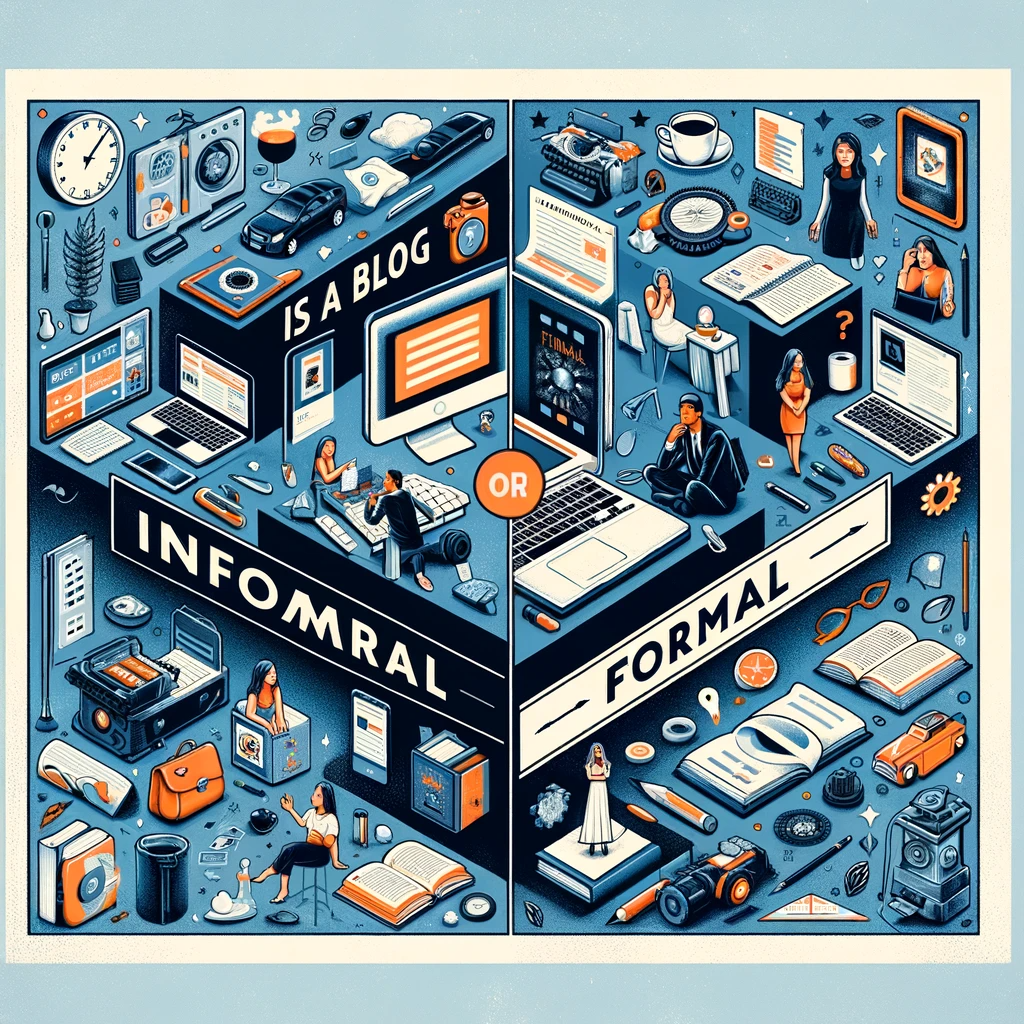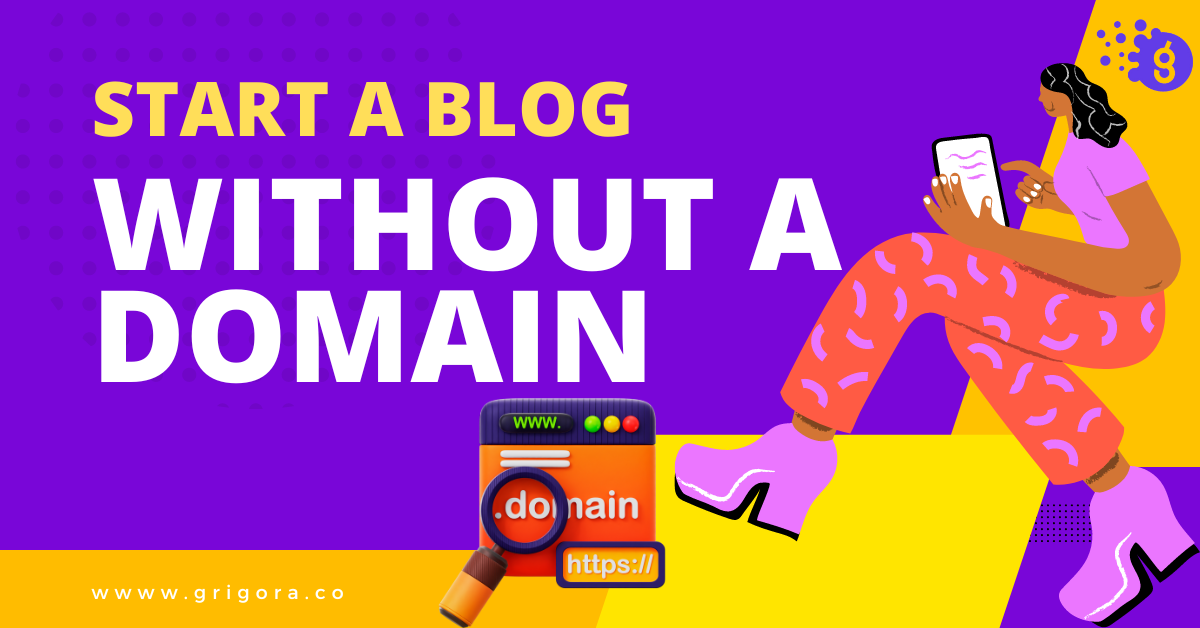Introduction
In the vast realm of digital communication, blogs have risen to prominence as a formidable means of disseminating information, perspectives, and narratives to a global audience. As we embark on the journey to explore the dichotomy of informal versus formal blogs, it is imperative to first establish a comprehensive understanding of what blogs represent and how they have evolved over time.
Defining Blogs
A blog, colloquially referred to as a "weblog," stands as a dynamic online platform where individuals, businesses, or organizations consistently publish content in a chronological sequence. These discrete units of content, more commonly known as "blog posts," span a broad spectrum of topics, encompassing personal anecdotes, subject matter expertise, breaking news, and captivating entertainment. Blogs serve as a digital canvas, offering authors an avenue to articulate their thoughts, connect with a global readership, and partake in meaningful dialogues.
The Evolution of Blogging
The genesis of blogging traces its origins back to the late 1990s when it initially emerged as a medium for online diaries. During this nascent phase, blogs predominantly functioned as outlets for individuals to document their daily lives and share personal reflections. However, the trajectory of blogging has witnessed a profound transformation over the years, evolving into a versatile and multifaceted medium.
Blogging is not just about publishing. It's about sharing, connecting, and building a community.
Darren Rowse
The annals of blogging history attest to the fact that what commenced as digital diaries has matured into a diverse and dynamic platform that accommodates a multitude of intentions and styles. In the forthcoming sections, we will embark on an exploration of the perennial debate between informal and formal blogs. We will delve into the defining attributes that delineate these two distinctive styles and dissect the advantages and disadvantages each brings to the fore. Through this expedition, you will emerge equipped with the knowledge to make judicious decisions regarding your preferred blogging style and objectives.
Informal Blogs: A Closer Look

Informal blogs, often cherished for their authenticity and relatability, present a distinct style in the world of blogging. Let's dive deeper into the defining characteristics, examples, and the pros and cons of informal blogs.
Characteristics of Informal Blogs
Informal blogs are defined by their:
Personal Tone: Authors adopt a conversational and personal tone, making readers feel as if they are engaging in a friendly conversation with the writer.
Casual Language: Informal blogs employ everyday language and colloquial expressions, creating an approachable atmosphere.
Diverse Content: These blogs cover a wide array of topics, from hobbies and interests to personal experiences and anecdotes.
Examples of Informal Blogs
Examples of informal blogs include:
Lifestyle Blogs: These blogs share personal experiences, travel adventures, and daily routines, often with a touch of humor and relatability.
Mommy Blogs: Focused on parenting, mommy blogs share stories, tips, and challenges in a friendly and empathetic manner.
Food Blogs: Food enthusiasts use informal blogs to feature home-cooked recipes, restaurant reviews, and culinary explorations, often with a warm and inviting tone.
Pros and Cons
Pros and Cons of Informal Blogs
| Pros of Informal Blogs | Cons of Informal Blogs |
|---|---|
| 🌟 Authenticity: Readers appreciate the genuine and authentic voice, building trust. | ❌ Lack of Authority: May not be perceived as authoritative sources in certain niches. |
| 🚀 Engagement: Strong reader engagement and a sense of community. | 💰 Limited Monetization: Challenges in monetization compared to formal blogs. |
| 🎨 Flexibility: Freedom to explore diverse topics and writing styles. | ⏰ Inconsistent Posting: Maintaining a regular posting schedule can be challenging. |
Formal Blogs: A Deep Dive

Formal blogs, in contrast to their informal counterparts, exhibit a structured and professional approach to content creation. Let's delve deeper into the defining characteristics, examples, and the pros and cons of formal blogs.
Characteristics of Formal Blogs
Formal blogs are characterized by:
Professional Tone: Authors maintain a formal and professional tone, often adhering to established writing conventions.
Specialized Content: These blogs focus on niche topics and industries, offering in-depth insights and expertise.
Structured Layout: Formal blogs typically feature organized and structured content, often with clear headings and subheadings.
Examples of Formal Blogs
Examples of formal blogs include:
Business Journals: These blogs provide industry-specific insights, analysis, and news updates with a formal tone.
Academic Blogs: Authored by experts, academic blogs delve into research, studies, and scholarly discussions.
News Outlets' Blogs: Many news organizations maintain formal blogs that cover current events and analysis in a professional manner.
Pros and Cons
| Aspect | Pros 👍 | Cons 👎 |
|---|---|---|
| Credibility | Formal blogs are often seen as authoritative sources, enhancing the author's credibility. | Limited Engagement: Formal blogs may struggle to create a strong sense of community and engagement compared to informal ones. |
| Monetization Opportunities | These blogs may attract advertisers and sponsors due to their professionalism. | Time-Intensive: Maintaining a formal blog can be time-consuming due to in-depth research and structured writing. |
| Structured Content | The organized layout and clear structure enhance readability and comprehension. | Narrow Audience: The specialized nature of formal blogs may limit their |
The Grey Area: Semi-Formal Blogs
Amid the dichotomy of informal and formal blogs, there exists a middle ground known as semi-formal blogs. This section aims to shed light on what semi-formal blogs are and when they might be the right choice for your blogging endeavors.
What Are Semi-Formal Blogs?
Semi-formal blogs occupy the space between informality and formality. They are characterized by:
Balanced Tone: Authors strike a balance between a personal and professional tone, offering a friendly yet informative atmosphere.
Mixed Content: Semi-formal blogs may cover a range of topics, allowing authors to express their personality while providing valuable information.
Moderate Structure: While not as structured as formal blogs, they maintain a moderate level of organization in their content.
When to Choose Semi-Formal Blogging
Semi-formal blogging might be the right choice in scenarios such as:
Balancing Personal and Professional: When you want to share personal experiences and insights while maintaining professionalism.
Diverse Content Range: If your content spans multiple topics and you wish to cater to a broad audience.
Engagement and Credibility: Striving for a balance between reader engagement and establishing credibility in your chosen niche.
Informal vs. Formal: Content Style Comparison
One of the defining aspects of informal and formal blogs is their distinct content style. In this section, we will delve into the differences in writing style and the use of visual elements in these two blog categories.
Writing Style Differences
Informal Blogs:
Conversational Tone: Informal blogs adopt a conversational tone, akin to chatting with a friend.
Casual Language: Authors use everyday language, colloquialisms, and a relaxed writing style.
Engaging Stories: Narrative elements and personal anecdotes are common in informal blogs.
Formal Blogs:
Professional Tone: Formal blogs maintain a professional and authoritative tone, often adhering to industry-specific writing conventions.
Technical Language: Authors use industry-specific terminology and maintain a more structured writing style.
Factual Information: Formal blogs prioritize facts, data, and research to support their content.
Visual Elements in Informal vs. Formal Blogs
Informal Blogs:
Images and GIFs: Informal blogs frequently use images, GIFs, and memes to enhance engagement and entertainment.
Emojis and Icons: Authors may incorporate emojis and icons to convey emotions and reactions.
Varied Formatting: Informal blogs may have irregular formatting, with varying font sizes and colors.
Formal Blogs:
Infographics and Charts: Formal blogs use infographics, charts, and graphs to present data and statistics.
Minimalistic Design: A clean and structured design is often preferred in formal blogs to maintain professionalism.
Consistent Formatting: Formal blogs adhere to a consistent formatting style, including font choices and color schemes.
Audience Engagement: Informal vs. Formal
Engaging with your audience is a fundamental aspect of successful blogging. In this section, we will explore the strategies for connecting with readers in both informal and formal blogs, along with how to measure engagement effectively.
Connecting with Readers in Informal Blogs
Informal blogs thrive on personal connections and relatability. Strategies for audience engagement in informal blogs include:
Interactive Language: Use conversational language to create a sense of intimacy with your readers.
Storytelling: Share personal anecdotes and stories to captivate your audience's emotions.
Community Building: Encourage comments, discussions, and user-generated content to foster a sense of community.
Emojis and Reactions: Utilize emojis and reaction buttons to encourage reader feedback and express emotions.
Reader Q&A: Host Q&A sessions or address reader questions to strengthen the bond with your audience.
Engaging the Audience in Formal Blogs
Formal blogs, while maintaining professionalism, can also create meaningful engagement. Strategies for audience engagement in formal blogs include:
In-Depth Content: Provide comprehensive and well-researched content that adds value to your readers.
Citing Sources: Cite reputable sources and research to establish credibility.
Thoughtful Responses: Respond to reader comments with thoughtful and informative replies.
Webinars and Workshops: Host webinars or workshops to educate and engage your audience.
Newsletter Subscriptions: Encourage readers to subscribe to newsletters for updates and exclusive content.
Measuring Engagement
Both informal and formal blogs can benefit from measuring engagement through:
Analytics Tools: Utilize web analytics tools to track user interactions, page views, and audience demographics.
Engagement Metrics: Monitor metrics such as likes, shares, comments, and time spent on the blog.
Surveys and Feedback: Collect feedback from readers through surveys or feedback forms to understand their preferences.
Blogging Goals and Objectives
Establishing clear goals and objectives is essential for a successful blogging journey. In this section, we will discuss how to align your blogging goals with your chosen style, be it informal or formal, and explore strategies to achieve them.
Matching Goals with Blog Style
Informal Blogs:
Community Building: If your goal is to build a vibrant online community, informal blogs excel in fostering engagement and connection.
Personal Branding: Informal blogs are ideal for creating a personal brand, as they allow you to showcase your personality and relatability.
Entertainment and Engagement: If your primary objective is to entertain and engage readers, the informal style's storytelling and conversational tone can be highly effective.
Formal Blogs:
Authority and Expertise: Formal blogs are suited for establishing authority and expertise in a specific niche or industry.
Educational Content: If your goal is to provide in-depth and educational content, the formal style's structured approach and professionalism are advantageous.
Monetization and Business: Formal blogs can attract business opportunities, sponsorships, and partnerships due to their credibility and professionalism.
Strategies for Achieving Goals
Informal Blogs:
Consistent Interaction: Regularly engage with your audience through comments, social media, and live sessions to foster community.
Personal Storytelling: Leverage personal anecdotes and experiences to connect with readers on a personal level.
Collaborations: Collaborate with other bloggers or influencers to expand your reach and community.
Formal Blogs:
In-Depth Research: Invest time in thorough research and fact-checking to establish credibility and authority.
Guest Posts: Contribute guest posts to authoritative websites in your niche to build credibility and reach a wider audience.
Email Marketing: Implement email marketing campaigns to share valuable insights and build a loyal readership.
Monetization: Which Approach Works Best?
Monetizing your blog is a pivotal aspect of achieving sustainability and profitability. In this section, we will explore the monetization strategies that align with either informal or formal blogs.
Informal Blog Monetization Strategies
Informal blogs offer unique monetization opportunities, although they may differ from those of formal blogs:
Affiliate Marketing: Promote products or services you genuinely endorse and earn commissions on sales generated through your affiliate links.
Sponsored Content: Collaborate with brands for sponsored posts that match your blog's informal and relatable tone.
Merchandise Sales: Create and sell merchandise featuring your blog's branding or catchphrases.
Donations and Crowdfunding: Encourage your engaged community to support your blog through donations or crowdfunding platforms.
Formal Blog Monetization Strategies
Formal blogs, with their authoritative and professional tone, have distinct monetization opportunities:
Ad Revenue: Display ads from ad networks that cater to your niche and audience.
Consulting and Coaching: Leverage your expertise to offer consulting or coaching services in your niche.
Premium Content: Charge readers for access to premium, in-depth content, reports, or research.
Webinars and Workshops: Host paid webinars or workshops to educate your audience.
Sponsored Content: Collaborate with brands for sponsored posts, adhering to the formal and professional style.
SEO Impact: Formal vs. Informal Blogs
Search Engine Optimization (SEO) plays a pivotal role in driving organic traffic to your blog. In this section, we will explore the differences in SEO strategies between informal and formal blogs, including key ranking factors.
Search Engine Optimization Differences
Informal Blogs:
Keyword Usage: Informal blogs may naturally incorporate keywords into conversational content. Long-tail keywords are often effective.
User Engagement: High user engagement, including comments and social shares, can positively impact SEO.
Visual Content: Incorporating images, videos, and multimedia content can enhance engagement and SEO.
Formal Blogs:
Keyword Research: Formal blogs often prioritize extensive keyword research to identify high-value keywords in their niche.
Structured Content: Formal blogs tend to employ clear headings, subheadings, and organized content, aiding search engine readability.
Backlinks: Building authoritative backlinks from reputable sources is crucial for formal blogs to boost SEO.
Ranking Factors
Informal Blogs:
Informal blogs can excel in local SEO and voice search optimization, catering to a conversational style that aligns with natural language queries.
Formal Blogs:
Formal blogs may benefit from authoritative backlinks, optimized on-page SEO, and comprehensive content that aligns with user intent.
The Blogging Spectrum: Finding Your Style

Blogging is a diverse field that accommodates a wide range of styles and approaches. In this section, we will explore the concept of the blogging spectrum, helping you define your blogging identity through considerations of personal branding, content niche, and target audience.
Personal Branding
Informal Branding: Informal blogs often revolve around building a personal brand, where your unique personality and relatability are central to your identity.
Formal Branding: Formal blogs focus on professional branding, establishing authority and expertise in a specific niche or industry.
Content Niche
Informal Niche: Informal blogs can encompass a broad range of topics, catering to diverse interests and personal experiences.
Formal Niche: Formal blogs are specialized, focusing on in-depth content within a specific niche or industry.
Target Audience
Informal Audience: Informal blogs attract readers seeking relatability, entertainment, and a personal connection.
Formal Audience: Formal blogs appeal to readers seeking authoritative and informative content within a specialized field.
Blogging Tools and Platforms
Selecting the right tools and platforms is crucial for a seamless and productive blogging experience. In this section, we will explore the tools available for both informal and formal bloggers and consider platform considerations.
Tools for Informal Bloggers
Informal bloggers often benefit from tools that enhance engagement and creativity:
Blogging Platforms: Popular platforms like WordPress, Blogger, and Medium provide user-friendly interfaces for creating informal content.
Social Media Tools: Tools for managing and scheduling social media posts to promote informal blog content.
Visual Content Creation: Graphics and video editing tools to create engaging visual content.
Tools for Formal Bloggers
Formal bloggers require tools that facilitate research, data presentation, and professionalism:
Content Management Systems (CMS): Robust CMS platforms like WordPress or Drupal for structured content creation.
SEO and Analytics Tools: Tools for keyword research, SEO optimization, and analytics tracking.
Research and Citation Tools: Tools for in-depth research, citation management, and data analysis.
Platform Considerations
The choice of blogging platform is a critical decision:
Self-Hosted Blogs: Offer greater control and customization but require technical expertise.
Third-Party Platforms: Provide simplicity and ease of use but may have limitations in terms of customization.
Case Studies
Real-world case studies provide valuable insights into the strategies and journeys of successful bloggers in both the informal and formal realms. In this section, we will explore some success stories to learn from their experiences.
Success Stories of Informal Bloggers
Case Study 1: Lifestyle Blogger Extraordinaire
A lifestyle blogger with an informal style built a dedicated following by sharing personal experiences and relatable content.
Engaged with the audience through regular Q&A sessions and community-building activities.
Monetized through sponsored posts, affiliate marketing, and merchandise sales.
Key Takeaway: Authenticity and relatability can lead to a strong and engaged community.
Case Study 2: The Food Enthusiast
An informal food blogger established a loyal readership by sharing home-cooked recipes and restaurant reviews.
Regularly used images, GIFs, and emojis to enhance engagement.
Monetized through sponsored posts, recipe e-books, and cooking classes.
Key Takeaway: Visual content and engagement techniques are valuable for informal bloggers.
Success Stories of Formal Bloggers
Case Study 1: The Niche Authority
A formal blogger in the finance niche established authority through in-depth research and technical content.
Built backlinks through guest posts on authoritative finance websites.
Monetized through premium content subscriptions and consulting services.
Key Takeaway: Specialized knowledge and authority can attract lucrative opportunities.
Case Study 2: The Academic Luminary
An academic blogger with a formal approach gained recognition by publishing research studies and scholarly articles.
Attracted a professional audience seeking authoritative content.
Monetized through consulting services, academic writing, and premium research reports.
Key Takeaway: Formal blogs can excel in specialized niches with valuable expertise.
Content Calendar and Planning
Consistency and organization are essential for a successful blogging journey. In this section, we will explore the importance of content planning, content calendars, and how to effectively manage your blog's content.
Planning for Informal Blogs
For informal blogs, consider the following content planning strategies:
Diverse Topics: Plan a variety of topics that resonate with your audience's interests and your personal experiences.
Seasonal Content: Align your content with seasons, holidays, or trending topics to stay relevant.
Regular Engagement: Schedule interactive posts, Q&A sessions, or challenges to maintain reader engagement.
Planning for Formal Blogs
Formal blogs benefit from a structured content planning approach:
Editorial Calendar: Create an editorial calendar with planned topics, publication dates, and content structure.
Keyword Research: Incorporate high-value keywords into your content plan to target your niche effectively.
Research Time: Allocate time for in-depth research, data collection, and fact-checking in your content schedule.
Measuring Success
Evaluating the performance of your blog is essential for ongoing improvement and achieving your blogging goals. In this section, we will explore the key metrics to measure success for both informal and formal blogs.
Metrics for Informal Blogs
Engagement Metrics: Track likes, comments, shares, and the number of active community members to assess reader engagement.
Social Media Metrics: Monitor follower growth, engagement, and referral traffic from social media platforms.
Audience Feedback: Gather feedback through surveys or comments to understand reader preferences and interests.
Metrics for Formal Blogs
Traffic and Analytics: Analyze website traffic, page views, bounce rates, and user demographics using analytics tools.
Conversion Rates: Measure the conversion of readers into subscribers, customers, or clients through call-to-actions.
Backlink Profile: Evaluate the quantity and quality of backlinks to assess your blog's authority.
Time on Page: Assess the average time readers spend on your content, indicating engagement and content quality.
Challenges and Pitfalls
Blogging, whether informal or formal, comes with its share of challenges and potential pitfalls. In this section, we will explore common challenges faced by bloggers in both styles and strategies to overcome them.
Common Challenges in Informal Blogging
Consistency: Maintaining a regular posting schedule can be challenging due to the informal nature of content.
Monetization: Informal bloggers may face difficulties in monetizing their blogs compared to formal bloggers.
Content Quality: Balancing relatability with high-quality content can be a challenge.
Common Challenges in Formal Blogging
Research Intensity: Formal blogs often require extensive research, which can be time-consuming.
Building Authority: Establishing authority and gaining recognition in a niche can take time and effort.
Engagement: Maintaining engagement in a formal style can be more challenging compared to informal blogs.
Legal and Ethical Considerations
Maintaining ethical and legal standards is essential for bloggers in both informal and formal styles. In this section, we will explore key considerations, including copyright and plagiarism, as well as the importance of transparency and disclosure.
Copyright and Plagiarism
Informal Blogs: Be cautious when using images, memes, or content from other sources. Always provide proper attribution and seek permission when necessary.
Formal Blogs: Rigorously adhere to copyright laws and academic integrity. Properly cite all sources and use plagiarism detection tools when conducting research.
Disclosure and Transparency
Informal Blogs: Clearly disclose any sponsored content or affiliate marketing relationships to maintain transparency with your audience.
Formal Blogs: In academic or professional contexts, maintain transparency by disclosing conflicts of interest and funding sources in your research or content.
FAQs
Is one style better than the other?
There is no one-size-fits-all answer. The choice between informal and formal blogging styles depends on your goals, target audience, and personal preferences. Informal blogs emphasize relatability and personal connections, while formal blogs prioritize authority and expertise.
Can I switch between informal and formal blogging?
Yes, you can transition between styles if it aligns with your evolving goals and audience. Be prepared to adapt your content, tone, and branding accordingly.
How do I maintain consistency in my blog style?
Consistency is key to maintaining your chosen style. Create an editorial calendar, define your content strategy, and engage with your audience regularly to establish and maintain your blogging identity.
Conclusion
In the dynamic world of blogging, the choice between informal and formal styles is a pivotal decision that shapes your blogging journey. Both styles offer unique advantages and cater to different goals and audiences.
Revisiting the Informal vs. Formal Debate
As you reflect on the insights provided in this article, remember that:
Informal blogs thrive on relatability and personal connections, making them ideal for personal branding and community building.
Formal blogs excel in establishing authority and expertise, attracting niche audiences seeking in-depth, credible content.
Final Thoughts on Effective Blogging
Ultimately, the success of your blog lies in your ability to connect with your audience, deliver valuable content, and achieve your goals. Regardless of your chosen style, keep these principles in mind:
Be authentic and true to your blogging identity.
Consistency is key to maintaining reader trust and engagement.
Adapt and evolve as your audience and goals change.



